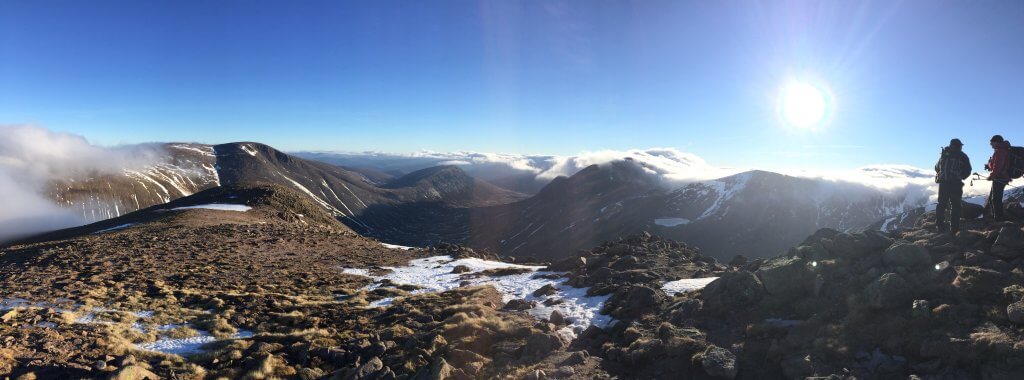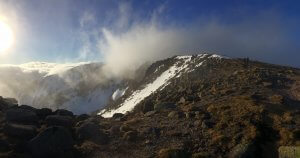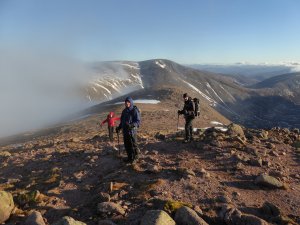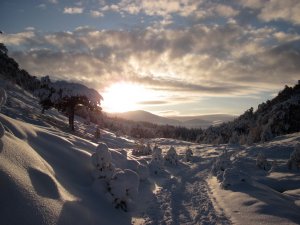What a week of Guided winter walking in Scotland – almost 4 seasons in one week! From full whiteout blizzard to stunning views for miles from the summit of Braeriach, enhanced by a broken spectre with 2 silhouettes in the middle.
From conditions like this:
To glorious views like this:
 Stunning views to compensate for the lack of snow cover in the Cairngorms (courtesy of Claire Grogan)
Stunning views to compensate for the lack of snow cover in the Cairngorms (courtesy of Claire Grogan)
The weekend at the beginning of the trip offered the worst of the weather, but unfortunately if you have to get back to work … maybe next time those who couldn’t stay on will be treated to views similar to those from Braeriach at the end of the week.
“Thank you again for a very enjoyable week. Andy’s knowledge of the mountains and of the geology, flora and fauna, together with the welcoming and homely atmosphere and Rebecca’s cooking makes for a great combination”
These are just a selection of some of the points which have made the week so memorable and will hopefully serve as talking points when everyone gets home.
Group:
included
– a diverse group of individuals (including one couple) united by a common interest.
We saw a vole and it didn’t just pop out and disappear; it stayed and snuffled around searching for food. We have a really good view of it.
Sightings of ptarmigan became quite common place as the week went on. The first was exciting but by the end of the week, we’d had at least 5 sightings. Ptarmigan sightings were exciting for one of our guests whose young grandson (under 10 years old) is a keen birdwatcher, so it was something he could share with him.
We spotted golden eagle and mountain hare in the white winter plumage.
Many a hiker would love to be treated to a broken spectre. It adds a certain “je ne sais quoi” to the day and provides a talking point. Everyone wanted to see the pics (and it certainly proved popular on our social media.
Panoramic photos courtesy of Claire Grogan
 Stunning winter views in the Cairngorms highlighted by a slight wisp of cloud to add character to the picture
Stunning winter views in the Cairngorms highlighted by a slight wisp of cloud to add character to the picture Not so wintry in the Cairngorms but still enjoying the company and repartee as the group ascends the ridges in the Cairngorms
Not so wintry in the Cairngorms but still enjoying the company and repartee as the group ascends the ridges in the Cairngorms
Check out our Facebook album for a fuller collection of the photos taken during our trip.
Lentil loaf – a great vegetarian recipe to have up your sleeve for parties/dinners with friends.
Other food: Recipes going live shortly:
Beetroot brownies
Banana and fruit loaf pudding
Grasmere gingerbread
Raspberry and pine nut bars
Tear and share tomato and cheese bread
A great group who enjoyed the variety of walking options during the week and did perhaps feel that they accomplished more in the week than they would have done without Andy’s guidance.
Winter is a time where people retreat inside and exercise unfortunately takes a backseat. Well not at Scot Mountain Holidays! With the gorgeous Scottish countryside transformed into a winter wonderland, the cooler season becomes one of our favourite. Winter walking also has many benefits. These include, staying active, clear winter views and a sense of accomplishment. So for winter walkers old and new; here are our top tips for winter walking.
 Winter scenery in the Ryvoan valley, taken by Thomas Barratt on a course with Scot Mountain Holidays
Winter scenery in the Ryvoan valley, taken by Thomas Barratt on a course with Scot Mountain HolidaysIt makes sense that one of the most important things to consider for winter walking is your own comfort. Layering up is a great way to stay warm, and allows easy accessibility to avoid overheating. Avoid materials that will stick to your skin if wet and go for Thermals, fleeces and waterproof jackets.
Getting the right gear for winter walking is vital. Waterproof trousers and jackets are a must have to compete with the mist and snow you might experience. Goggles are a great idea for your face protection along with a buff. And of course, remember to protect your extremities with gloves and a warm hat. However, arguably the most important is boots. Invest in a good pair of hiking boots that have grip and ankle support. Keep in mind that boots, and gear is available for hire through Scot Mountain Holidays, so don’t despair if you don’t have everything you need.
Before heading out ensure you have a big warm breakfast of something substantial. This will keep you’re energy levels up, warm you up and be the right move in starting your day right.
Whether you’re on a guided walking tour with Scot Mountain Holidays or a self guided tour, staying active in the elements is very important. Although you may be tired, remember hyperthermia can set in if you are stationary for too long. So keep your breaks to a maximum of ten minutes, and try to nibble on something every time you stop.
We know that keeping your fluids up in winter is harder than in summer. But, it is by no means less important. When winter walking it’s important to stay hydrated. So similar to eating, remember to hydrate every time you stop and keep your bottle somewhere warm to avoid freezing.
Winter has well and truly hit Scotland and now’s the time to join Scot Mountain Holidays on a winter walking tour. Our top tips for winter walking is just the thing to get you active and reap the rewards this winter.
“It’s all in the Wood” – or how to choose great malt whisky
Adventure Guide Andy Bateman of Scot Mountain Holidays guides you through the mist of romance and hype, and around the pitfalls in choosing a fine bottle of malt whisky.
Scottish Malt Whisky is simply not Scotch unless it’s been matured in an oak cask. Up until this point it is just spirit from the still. Essentially a mix of alcohol & water plus e.g. elements of smoke should the barley been dried over a peat fire.
A complex interaction between the oak and the spirit takes place during maturation with the alcohol drawing out many of the oils and other components of the wood. It’s the presence of these oils that gives the whisky’s depth of flavour and breadth of character. This is what Malt Whisky is so let’s look at ‘journey” these oils take during the whisky making process.
Quality of the Wood – are the oils still present?
Firstly, if there isn’t quality in the wood you won’t get the quality in the whisky. The oak casks are used a number of times and with each maturation, oils are removed from the wood. If you mature spirit in an exhausted cask, it doesn’t matter how long it slumbers, the whisky will lack quality. The two questions that need to be asked are:
How many times the cask has been used previously?
The majority of Scotch Malt Whisky is matured in ex-American Bourbon casks. This first maturation of Bourbon removes the harsher notes from the new oak. After the subsequent 1st and 2nd maturations of Scotch Malt whisky the wood starts to loose it’s quality. Up to 60% of the vital ingredients can be drawn out during the first maturation with the whisky produced from 3rd and subsequent maturations often being of a lower standard.
Malt whisky production is a batch process and each cask has its own individual characteristics depending on a range of factors. The world of single cask malt whisky is infinitely varied. For the malt marketeer this has traditionally presented a problem of consistency. Understandably when you find a whisky you like, you want to know that the next bottle will taste the same. This is where the Master Blender (aka “The Big Nose”) comes in. They will marry together up to 100 casks from the same distillery to produce a consistent single malt*. Some of these will be good 1st or 2nd refill casks, others will be the not-so-good 3rd or 4th generation.
* A blended whisky is a mixture of malt whiskies from different distilleries and grain whisky.
has the spirit had enough time to draw the oils out of the wood?
The traditional length of time that the spirit needs to mature is an issue for the industry. Due to demand there has been a recent tendency to downplay the importance of the age. Traditionally it was around 10 years or more. Some have partly got around it by decreasing the cask size to increase the wood to spirit ratio and hence shorten the maturation period. Laphroaig’s Quarter Cask expression being a prime example. There are some good young single malts but this is not to infer the maturation period is not a very important part of the process. It takes time for the oils to be drawn out of the wood. The harsher flavours are softened over time and so the age is an important factor in the quality of the final product.
Scotch Whisky is matured in the cask above 60% ABV i.e. “Cask strength”. The market for Cask Strength whisky is small and most people who enjoy a tipple find it too strong. Diluting cask strength whisky down to the industry agreed standard of around 40% abv greatly improves the marketability through reducing the price as well as improving the palate.
The problem now is the equilibrium that established itself in the cask is altered and there is now no longer a high enough concentration of alcohol to support the oils. There is a tendency to for the whisky to go hazy.
To overcome this problem the long chain oils in most commercial malt whisky are removed by chill filtering but it is these longer chain oils that give the whisky it’s depth of flavours and breadth of “character”. The chill filtering also removes some of the variability and makes the Master Blenders job a little easier in creating that brand flavour.
A large number of commercial malt whiskies are coloured with the addition of Caramel. This also affects the flavour of the whisky.
Distilleries are often produce casks which don’t fit in with the taste profiles they wish to create and are happy to sell these on to Independent Bottlers. It’s through these companies that you often get some of the best whisky at a good price.
Check out hiking holidays incorporating Whisky : Walking, Whisky & Wildlife or Mountains and Malts
Recommended distillery tours from Fraoch Lodge: Aberlour, Glenlivet, Glenfiddich. You could also try our self-guided whisky story tour, based from Fraoch Lodge
All content © Copyright Scot Mountain Holidays 2024
Responsive web design by Summit Web Solutions